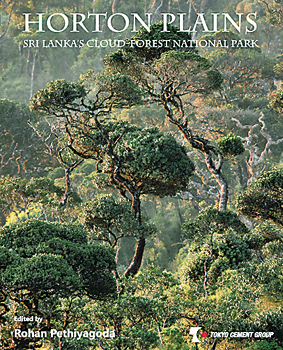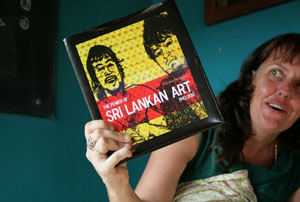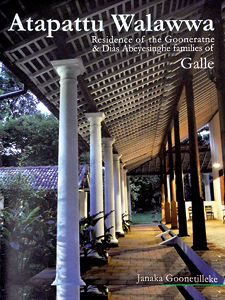Window on the Plains
It is a pleasure to review “Horton Plains: Sri Lanka’s cloud-forest national park”, the joint work of a dozen authors and two dozen photographers, compiled and edited by Rohan Pethiyagoda, who is well known for his many contributions to biodiversity science in Sri Lanka. It establishes a new genre for national-park guide books in Sri Lanka: a thoroughly informative text, richly illustrated and painstakingly detailed. With more than 300 pages it may look like a coffee-table book, but you would lay this on a coffee table at your peril. It is arguably the ultimate national park guide, and I could not help wondering why no one has written a similar book on Yala. After all, Yala has a wealth of animals of arguably greater charisma and appeal—elephant, leopard, bear, bird life, landscape and much else—but except for a plethora of photography books, there is hardly any literature. Ask what fishes swim in the Menik Ganga that passes through Yala and you’ll come up empty handed—no one knows.
Unlike Yala, Horton Plains has hardly any “megafauna”.

You will learn that elephants were present at least until February 24, 1882 (that is the kind of detail the book provides!) and that leopards, though seldom seen, continue to roam the plains. Yet, Pethiyagoda and his colleagues have provided a fascinating and intricately detailed account of everything you always wanted to know about Horton Plains but were afraid to ask. Not only are the fish that swim in the Belihul Oya named and illustrated, so are the crabs and the shrimps, with a wealth of fascinating detail. This is the kind of book that every good tour guide should memorise and then recite to visitors as he shows them around the park.
Even if one did not know that Rohan Pethiyagoda spent his childhood as the son of a tea planter in the neighbourhood of Horton Plains, one would see immediately that this book has been an enduring labour of love. He clearly has a compelling devotion to minutiae, for example when he provides a few fascinating pages on Governor Robert Wilmot Horton, after whom the plains were named. Horton, he points out, not only founded what is now Royal College, but also, as far back as the 1830s, abolished slavery and caste discrimination, established a uniform legal system for Sri Lankans and their colonial overlords (with trial by jury) and separated the judiciary from the executive. And did you know that the poet Byron wrote one of his best-known poems for Lady Horton?
The 30-page historical chapter, meticulously researched, includes details of the first Europeans to make the ascent to the plains (on March 28, 1834), and includes excerpts from contemporaneous accounts by 19th-century notables such as Ernst Haeckel, Samuel Baker, Thomas Farr and Jonathan Forbes, together with portraits and illustrations of the plains from that period unearthed from various overseas museums and collections. Apart from these, the author delves also into the prehistory of the Plains, dating some 30,000 years back to when Stone Age people lived there, to explain why it looks the way it does.This is followed by a 30-page chapter on landscape, including specially-commissioned high-resolution satellite images of Horton Plains and some spectacular aerial photos, including some of World’s End from the far side of the valley and the difficult-to-access Galagama Falls, views that no ordinary visitor is ever likely to see.
Unusually for a national-park guide, the book devotes almost equal space to plants and animals: 90 and 122 pages, respectively. For the plants, Pethiyagoda is joined by Professors Nimal and Savitri Gunatilleke, an generously collegial gesture given that Savitri too, has a (2007) book on Horton Plains, though mainly a guide to the World’s End nature trail. Hundreds of plants are illustrated, mostly through colour photos, but in the case of a few common woody species, also with line drawings that help identify them. I feel certain that many of the flowers were photographed for the first time for this book, including the many species of nillu (Strobilanthes) and rare orchids such as Bulbophyllumtrimeni. All this is clearly the result of years of arduous field work: some species of nillu, for example, flower only every decade (and even then, briefly), so it is remarkable that almost all are illustrated in bloom!
Looking through the photographs one gets the impression that Horton Plains remains a virgin, unspoiled wilderness. Almost all signs of human influence have been carefully avoided so readers get the clearest idea of what this unique site must have looked like before we got there. It is only at the very end, in the chapter on conservation, that Pethiyagoda allows himself to be drawn into controversy, roasting the Asian Development Bank for its disastrous desecration of the site. He nevertheless presents an excellent overview of the conservation challenges that face Horton Plains and prescribes coherent remedies, all of which, Sri Lanka being what it is, will likely fall on deaf ears.
What makes the book additionally interesting are the many excursions the authors make to deal with offbeat questions that might occur to readers. Why, for example, do rainforest trees flush with red shoots? Why do hare have such long ears? Are the grasslands natural or the result of fire? How do you tell closely-related species of plants apart? Why do birds move through the cloud-forest in flocks? Why do horned lizards have a horn? These make fascinating reading and prepare you, if you have grandchildren as I do, for those endless sessions of “Why…?”
While authoring most of the animal chapters in collaboration with his former colleagues from the Wildlife Heritage Trust, Pethiyagoda has wisely co-opted specialists for chapters on those with which he is unfamiliar: Gehan de Silva Wijeyratne for birds, Michael and Nancy van der Poorten for butterflies and dragonflies, and Dinarzarde Raheem for snails. All these sections are richly illustrated and contain beautiful and possibly unique photos of rare species such as Green’s Silverline butterfly and the Highland Loris, both only recently re-discovered after absences of many decades.
The quality of the production of the book too, is superlative. It is printed in Singapore, which perhaps justifies its rather high price. It is difficult to decide, however, into what category this book falls. It has a 75,000-word text, so it is clearly not a coffee-table book even though it contains about 500 colour photographs, mostly of very high quality, by excellent photographers such as Vimukthi Weeratunga. It contains 320 pages, measures 28×22 cm and weighs more than 4 lb, which means it is not intended to be a field guide, either. Perhaps the word “sourcebook” might be the best description, for it seeks to bring together in one place just about everything that is known about Horton Plains while at the same time illustrating all the plants, animals and landscapes a visitor could ever hope to see.
It is a book I can recommend with confidence, and anyone planning a visit to Horton Plains would benefit greatly from reading it in advance or actually taking it with them. There are only a few shortcomings to which I can point. For example, I would have liked to see a map of the site in addition to the satellite images, as the latter are not always easy for someone unfamiliar with the landscape to understand.Also, for an author who has published many high-quality books, I was surprised to find two typos in the front-matter of the book, though the body of the text is carefully copy-edited and clean.
Few people have as good a grasp of Sri Lanka’s biodiversity, and the ability to communicate its wonder, as Rohan. He has crafted the book cleverly to appeal to the broadest readership, ranging from those who simply want to turn the pages and gasp at the photos, through to those who demand a full-fledged scientific treatment of complex topics such as montane-forest dieback. The text is cleverly compartmentalised so it is easy to find what you want while skipping the more scientific parts. In the Preface the authors fret that by trying to write a book for everyone they may have written a book for no one. They are wrong: this is a book almost everyone will find useful and informative.
comments powered by Disqus























